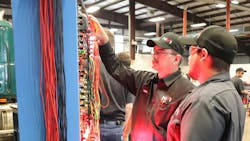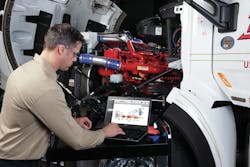If you’ve been to a commercial vehicle repair shop lately, you know how vital diagnostics are to getting trucks and vans in and out of the shop as quickly as possible. There are even dedicated triage bays in many shops where one of the more experienced technicians performs a quick health scan of a vehicle with diagnostic tools to determine the severity of the vehicle’s issues, which aids in deciding which units to work on first.
And as all trucks become more computerized, beyond just electrified and autonomous ones, this trend is accelerating at break-neck speed with new sensors and components providing oceans of data to commercial vehicle stakeholders, from OEMs and OEs to fleets and independent shops.
This technological transformation is changing how maintenance teams operate, as evidenced by the changing ratio of diagnostic tools to technicians.
“Until about 2020, the technician-to-tool ratio was 6-to-1,” revealed Sandeep Kar, Noregon System’s chief strategy officer, citing industry statistics. “Fast forward to 2022, it’s now 4-to-1, and by 2025 we are fully expecting it’s going to reach 2-to-1. So, for every two technicians there will be one diagnostic tool.”
These tools are crucial to fishing the right data points from that sea of information. And by having the right data, fleets can better prepare for whatever future challenges come their way, from supply chain and labor issues to electrification and inflation. This will be done by using data to predict equipment problems ahead of time, so maintenance supervisors have ample warning to get the right parts and people to fix the truck, and fleet managers can mitigate that unit’s downtime.
Read more: Four ways a fleet’s C-suite can improve diagnostics efficiency
As these dynamic changes take place, they’ll all need to rely on a diagnostic mindset to get to that point.
To do that, Fleet Maintenance gathered together subject-matter experts who can speak on all three facets for a discussion.
Kar represented Noregon, provider of the JPRO heavy-duty repair diagnostic solution. He now focuses on the pairing of data and diagnostics and how that will lead to more prescriptive maintenance solutions in the future. Twenty years ago, he worked for Tata Motors in India just when engine control units (ECUs) and engine control modules (ECMs) started to take off.
From NEXIQ, a division of Snap-on Inc. that provides the eTechnician truck diagnostic tool, was product manager David Shock, who started with Eaton as a technician in the late 1990s and has worked for NEXIQ since 2003.
Gary Beeman, CEO of nascent diesel and automotive school New Village Initiative (NVI) Institute, was also on hand to offer insights gleaned from watching the future diagnostic technicians learn how to troubleshoot and fix issues. Beeman, a former electrical engineer, cut his teeth in the industry developing diagnostic tools for the trucking industry about 25 years ago.
Here’s what they had to say:
[The following has been lightly edited for clarity and length.]
Fleet Maintenance: What was it like diagnosing trucks when you started your career, and what has changed to help improve uptime?
Beeman: In the mid-to-late ’90s, I helped develop what became the first all-in-one electronic diagnostic tester for trucks, and we did one for automotive as well. We worked with all the major OEs and fleets, engine manufacturers, etc.
The problem that the industry was having at the time was the proliferation of separate handheld diagnostic tools that only did one function. Fleets were having 20 to 50 tools in each service bay, and it was just becoming impossible to manage. We helped integrate that. It had a big impact on vehicle uptime to be able to integrate these tools and also increased the efficiency of the technicians who were using them by integrating some of these functions and speeding up the process. Therefore, that translated to vehicle uptime and more road miles.
Read more: Finding and retaining technicians: Understanding the supply and demand
Shock: An issue back then was you were given a description of the fault code. You weren’t given the full breadth of what would cause the fault code. You had to then pull the wiring diagrams and the manuals and part locators—you had to go in and look for that documentation, and they weren’t all in the same location, either. With today’s new tools, once you get the fault code, it gives you a deeper explanation of what actually caused the fault code, and the conditions the vehicle had to be in to trip that fault code. And then you get the wiring diagrams and some troubleshooting trees as well.
These tools can provide a part locator so you can actually find the parts on the vehicles. Especially with the aftertreatment system being so complicated, there also needs to be some graphical representation of the system.
FM: How has the industry’s relationship with data changed?
Kar: There have been massive tectonic shifts in how OEMs value data and then eventually collect data. Data is of paramount importance, and that’s not because OEMs just woke up one day and thought data is important. That’s because the very business model of truck manufacturing and sales is changing. The vehicle used to be a product back in those days. The vehicle is now considered a service—and in the future, the vehicle will be a solution. That business model transformation of a vehicle from a product to service to solution is built on the back of data as that most fundamental requirement.
And the OEM’s relationship with the customer does not end when the vehicle is sold. It begins at that point, and then throughout the life cycle of that vehicle, data-generated revenue streams are getting created. That is why data collection has become so important for OEMs.
I read a lot about how data is the new oil. I would agree with it somewhat, but also disagree because the data may be the new oil, but refined data, just as refined petroleum, is the new value-add. If you compare the value of the market cap of Halliburton, which is about $27 billion, and ExxonMobil, which is about $400 billion, you can understand what ExxonMobil does is add value on top of that oil by making it into gasoline. Businesses that are focused on refining that data and making it mission-critical, making it useful and intuitive to the end users, those are the businesses that are succeeding today and offering value in the form of diagnostic solutions.
Read more: Noregon CSO Sandeep Kar talks diagnostics, prognostics, and future of maintenance
Shock: I think that the big bridge in the future is how to connect maintenance records and financial records with diagnostic software. This means the software communicates with the back, end and it puts all the information together for them to see how long a repair took and why these vehicles are coming back more frequently.
There was a large fleet out there that did have a data analytics person analyze all their data. They found out the information they were getting wasn’t good enough, so they refined that information back down from the technician and service manager to make sure they got the proper information. A lot of times all you get is the fault code and the part to fix it—not the parts that were put into the vehicle that didn’t fix it. That’s just as important.
FM: What are some of the industry’s current diagnostic challenges?
Shock: Data mining is such a complicated thing to refine because the data comes in so many different fashions. You can have the same vehicle worked on by multiple technicians and have multiple solutions. And even though a diagnostic tool tells technicians what the problem is, they sometimes just don’t trust in it as they should.
And the second thing is training. We have such a technician shortage today; we don’t have time to send them to training, and that’s probably the biggest thing. A lot of training places are far away, so the technician will be out two or three days, or even a week, for training. A lot of shops don’t have the manpower to be without that technician. Something that would really help out is if we have localized training working with the community colleges; even having mobile training solutions where companies go out and work with a shop to do the training. The systems are getting so complex and there are so many different components to a truck nowadays, with electronics and ADAS, the aftertreatment system, and all the body control modules.
Read more: How sensors impact heavy-duty scan tools
Kar: There are different requirements in terms of monitoring how the business is running and those requirements manifest in the form of panoramic, as well as granular, insights on the business. The C-suite requires panoramic vision and people on the front line want granular insights. For us in the industry, the idea is to create dashboards as well as specific and accurate troubleshooting, analysis, and analytics that can empower everybody in the value chain.
The very value of that data is changing because in the past that data used to be leveraged to create descriptive solutions—something has happened to the vehicle and we are telling the technician or the business owner what has happened to the vehicle. We are moving towards predicting outcomes even before that. The future will be on prescriptive analytics where you can prescribe a certain outcome and then generate value in doing so. These innovations are meant to not only power the people on the front line who are turning the wrenches, but also people who are monitoring and managing businesses and driving more efficiency and effectiveness of their businesses.
FM: What are you hearing from fleets on what skills they want future diagnostic technicians to have?
Beeman: For the fleets, the dealers, for the OEs, and anyone involved in diagnostics, there is more and more need for information. We hear that right out of the gate every single time. Yes, our technicians need to have a basic understanding of vehicle mechanics, but now the percentage of sensors and computers is increasing, as is the wireless infrastructure going back to the company enterprise system.
Fleet maintenance managers are interested right away in the technician’s ability to run the diagnostic equipment and understand what it means, so more and more of the education is going towards that. Fortunately, the younger folks, in particular, are well versed in electronics—they grew up with it, they live with it, they can’t live without it. And that’s a good thing. That makes it a lot easier to introduce them to sophisticated diagnostics.
If they’ve been involved in gaming, and most of them have, there’s logic, detective work, and every skill you need. And you’re looking at screens, anticipating things. And so when we get them in front of the diagnostic equipment, they feel right at home, and they love it.
Read more: How to keep your top diagnostic technicians
FM: What are some ways fleets are benefiting from putting diagnostics first?
Kar: We see the immediate return on investment manifests in the form of reduced dwell time of vehicles in shops. You can really service a vehicle and get it out of the door sooner. Accurate and effective troubleshooting basically triggers downstream processes. It also helps to address the technician shortage when you have these tools available to technicians, as well as future-proofing shops. Vehicles are getting more and more complicated, so if you’re not equipped to effectively diagnose these vehicles through electronic scan tools, that’s a challenge. Overall, if you add it all together, it all translates to higher efficiency and a higher and better bottom line for the businesses.
FM: How can fleets decide on what type of diagnostic solutions and training to invest in?
Shock: They should start by talking to the shop and service managers. They know what their weaknesses are, where their strengths are. And the technician will know the vehicle better than the service manager and what triage tools are needed. They can work it out between the two of them, whether they need more technology or more training.
Kar: The shop or the fleet needs to rely on data and see which classes of vehicles tend to populate their shops more, or which duty cycles result in more frequent service and maintenance needs, or which key systems and components and modules fail more in that shop or come in with those failures. The goal here should be to reduce unscheduled maintenance. And that requires better technician training. There are also tools to remotely diagnose a vehicle, which can be used to remotely regen a DPF or other systems in a vehicle. Those are some of the questions the shop needs to answer before it makes a decision to choose a diagnostic solution provider or diagnostic tool. Because if more of those boxes are checked, more success can be derived from that investment.
Beeman: It does get to be difficult to know where to invest your money. We know that most fleets and vehicle dealers are short at least 20% manpower in their shops, and some 50%. Those are huge numbers. And technicians are the beginning and the end of what you do with data. They’re going to collect it, but also have to come to conclusions that are efficient for the company and will get the vehicle back on the road. The C-suite officers have a big challenge these days, partially because they do have so much data. And that’s the good news and the bad news—you’re going to have to figure out what to do with it.
About the Author

John Hitch
Editor-in-chief, Fleet Maintenance
John Hitch is the award-winning editor-in-chief of Fleet Maintenance, where his mission is to provide maintenance leaders and technicians with the the latest information on tools, strategies, and best practices to keep their fleets' commercial vehicles moving.
He is based out of Cleveland, Ohio, and has worked in the B2B journalism space for more than a decade. Hitch was previously senior editor for FleetOwner and before that was technology editor for IndustryWeek and and managing editor of New Equipment Digest.
Hitch graduated from Kent State University and was editor of the student magazine The Burr in 2009.
The former sonar technician served honorably aboard the fast-attack submarine USS Oklahoma City (SSN-723), where he participated in counter-drug ops, an under-ice expedition, and other missions he's not allowed to talk about for several more decades.


